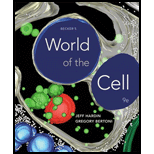
(a)
To show: At equilibrium,
Introduction: Free energy of a system is that amount of energy that can be changed into work in a system provided that the temperature and pressure of the system remain the same. It is denoted by
(b)
To determine: The amount of work that can be done by the system.
Introduction: Free energy of a system is that amount of energy that can be changed into work in a system provided that the temperature and pressure of the system remain the same. It is denoted by
Want to see the full answer?
Check out a sample textbook solution
Chapter 5 Solutions
Becker's World of the Cell (9th Edition)
- Only galactose need. Solve like samplearrow_forwardch Select all statements that are correct. Note there might be more than 1 correct statement. From the Lineweaver-Burk plot the equilibrium constant (Keq) can be obtained The Lineweaver-Burk plot gives a more accurate prediction for Vmax than the Michaelis- Menten plot The Lineweaver-Burk plot assumes that products and reactants are present at equal concentrations during the entire time of the reaction The Lineweaver-Burk plot shows velocity of reaction vs substrate concentration The Lineweaver-Burk plot shows 1/velocity of reaction vs 1/substrate concentration O 20°C D) // Earrow_forwardX Incorrect. Suppose that an uncatalyzed reaction is spontaneous because AG has a value of -10 kcal/mol. An enzyme that catalyzes the reaction is identified. What effect will the enzyme have on the rate of the reaction? Choose all that are correct. The enzyme increases the AG value. The enzyme increases the rate of reaction. The enzyme decreases the rate of reaction. The enzyme decreases the AG value. The enzyme raises the activation energy. The enzyme lowers the activation energy.arrow_forward
- Answer for the number 7 question, Thank you. No need for long explanation.arrow_forwardChemical labeling of chymotrypsin by the compound tosylphenylalanine chloromethyl ketone (TPCK) modifies the His 57 in the enzyme's active site. The structure of this derivative is shown below. TPCK inactivates the enzyme because the bulky addition prevents it from cleaving nearby covalent bonds. HCI + CH, C-O Chymotrypsin-His 57 TPCK Modified enzyme True O Falsearrow_forwardBalance the reactions. A hint is provided to help you decide if the reaction will proceed as written, ie from left to right. Do not leave any fractions. 1. a) Balance Al₂O3 → Al + 0₂ b) What type of reaction is this? c) Is this a redox rx, yes / no ? d) The reaction will go from left to right, yes / no ? (hint: O₂ is very reactive) 2. a) Balance HNO3 + AI → b) What type of reaction is this? c) Is this a redox rx, yes / no ? d) The reaction will go from left to right, yes / no ? (hint: aluminum is a reactive metal, and a gas escapes) C7H14 + 0₂ 3. a) Balance, leave no fractions b) What type of reaction is this? c) Is this a redox rx, yes / no ? d) The reaction will go from left to right, yes / no ? (hint: O₂ is very reactive) H2(g) + AI(NO3)3 → CO₂ + H₂Oarrow_forward
- Select all that apply. What is true about the conformational aspects of coupling? O The proton gradient is involved in the release of bound ATP from the synthase as a result of conformational change. O The conformational states interconvert as a result of proton flux through the synthase. There are two sites for substrate on the synthase and two possible conformational states: open (0) and tight-binding (T). Dinitrophenol binds to and inhibits ATP synthase conformational changes, thus inhibiting ATP synthesis. The Fo portion of ATP synthase acts as a rotary motor.arrow_forwardNeed help.arrow_forwardEnzymes catalyze chemical reactions. What constitutes the active site of an enzyme? What are the turnover number (kcat), the Michaelis constant (Km), and the maximal velocity (Vmax) of an enzyme? The kcat (catalytic rate constant) for carbonic anhydrase is 5 × 105 molecules per second. This is a “rate constant,” but not a “rate.” What is the difference? By what oncentration would you multiply this rate constant in order to determine an actual rate of prod- uct formation (V)? Under what circumstances would this rate become equal to the maximal velocity (Vmax) of the enzyme?arrow_forward
 BiochemistryBiochemistryISBN:9781305577206Author:Reginald H. Garrett, Charles M. GrishamPublisher:Cengage Learning
BiochemistryBiochemistryISBN:9781305577206Author:Reginald H. Garrett, Charles M. GrishamPublisher:Cengage Learning BiochemistryBiochemistryISBN:9781305961135Author:Mary K. Campbell, Shawn O. Farrell, Owen M. McDougalPublisher:Cengage Learning
BiochemistryBiochemistryISBN:9781305961135Author:Mary K. Campbell, Shawn O. Farrell, Owen M. McDougalPublisher:Cengage Learning

